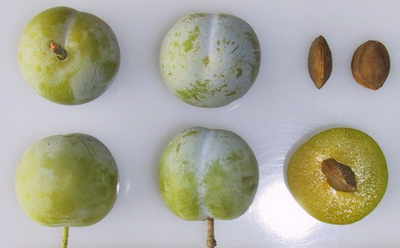Old Greengage
Description
Old Greenage is also called Reine Claude and Greengage. It is a population rather than a variety since it comes reasonably true from seed, having been interbred for centuries. It is called Reine Claude after the wife of the French King Francis 1st, 1494-1547. It came originally from Armenia, via Greece, but has been known in France since the late 15th century and in England since at least the late 16th century. It was mentioned by Parkinson as Verdoch, suggesting it might have arrived here via Italy. It has since been known as Verdoccia. In 1724 Sir William Gage, who had a garden at Hengrave Hall in Bury St Edmunds, acquired the green fruit but his gardener lost the label. It then became known as a green ‘Gage’. Medium sized yellow /green,fruit with transparent flesh, flushed amber. If eaten when exactly ripe, it is said to have the best flavour. Ripe in late August. There are conflicting claims on self fertility. Crops can be irregular.
|
Latin name: Prunus domestica
Type: dessert Uses: eating raw/ making jams Flavour: juicy, tender flesh with a most delicious flavour. Fruit colour: brown |
Flowering time: 17 April (start) 21 April (full) 7 May (over)
Picking time: early September Eating/storing time: a week or so in fridge Tree vigour: Rootstock: M25 Year planted: 2014 |

